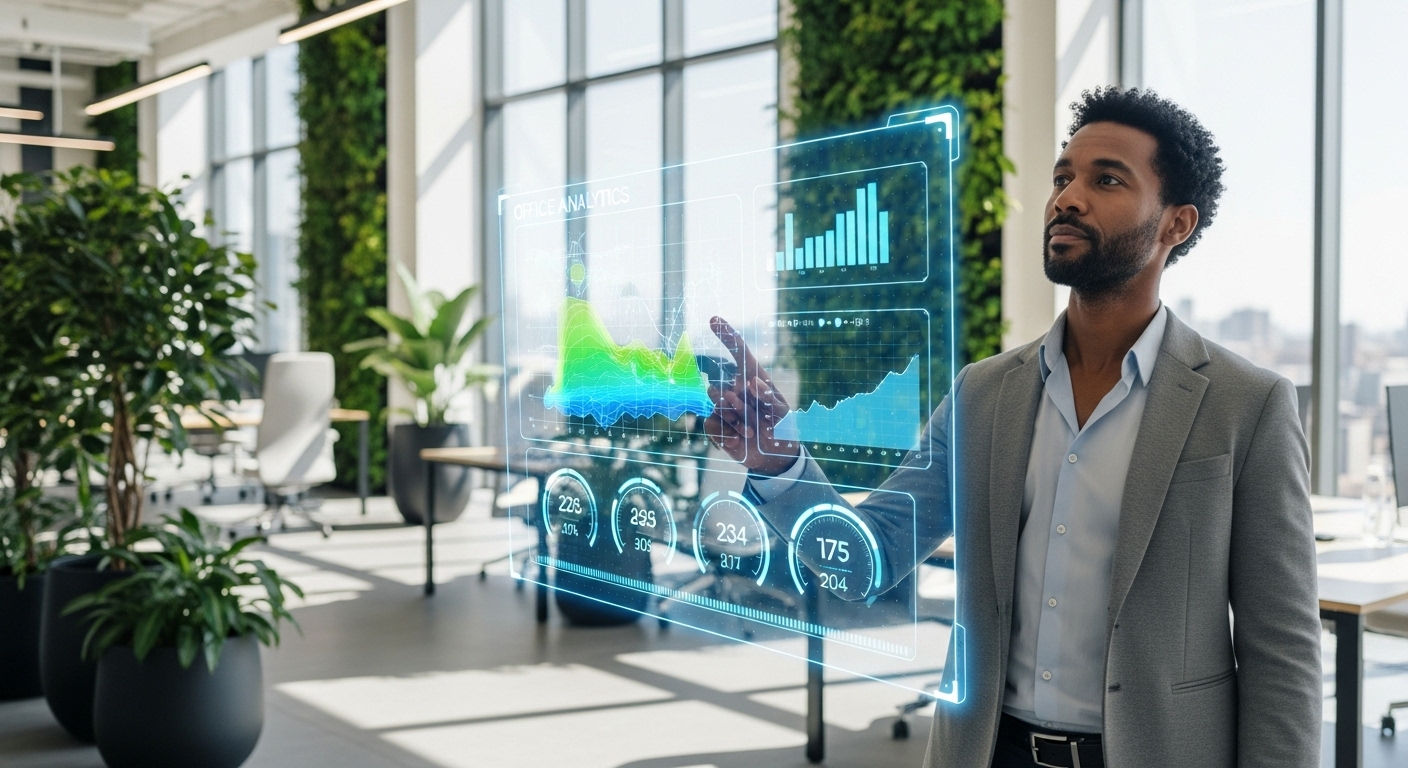In the evolving landscape of work, the term ‘smart office’ has become ubiquitous. Yet, many organizations invest in cutting-edge technology only to collect a deluge of data they don’t know how to use. The true revolution isn’t in the sensors or the connected devices; it’s in the translation of raw data into actionable business intelligence. As companies navigate the complexities of hybrid models and fluctuating office attendance, the ability to make data-driven decisions about space, resources, and employee experience is no longer a luxury—it’s a strategic imperative. This guide moves beyond the gadgets to provide a leader’s framework for leveraging smart office analytics. We will explore how to transform abstract metrics into tangible improvements, optimizing your physical workspace for productivity, well-being, and efficiency. By harnessing the power of analytics, you can ensure your office is not just smart, but strategically intelligent, adapting in real-time to the needs of your business and your people.
What Are Smart Office Analytics? A Primer for Leaders
At its core, smart office analytics is the process of collecting, analyzing, and interpreting data generated by various technologies within a workplace. It’s a significant leap from simply observing that an office feels busy or empty. This discipline provides empirical evidence to understand precisely how your space is being used. The data sources are diverse and interconnected, often including Internet of Things (IoT) sensors that track occupancy, environmental conditions, and resource usage. For instance, passive infrared (PIR) sensors can detect presence in rooms or at desks, while more advanced computer vision systems can anonymously count people in larger zones. Environmental sensors continuously monitor air quality (CO2, VOCs), temperature, humidity, and even ambient noise levels. This data is then fed into a centralized platform, often an Integrated Workplace Management System (IWMS), which uses algorithms to generate insights. For a leader, this means you can move from anecdotal feedback to concrete facts. Instead of guessing which meeting rooms are most popular, you can see utilization rates, peak booking times, and even ‘no-show’ percentages. You can understand which departments collaborate most frequently by analyzing their movement patterns and meeting habits. Smart office analytics provides a multi-layered, dynamic view of your workplace ecosystem, serving as the foundation for informed strategic decisions that impact everything from real estate portfolios to employee satisfaction.
Optimizing Space Utilization in the Hybrid Era
The rise of hybrid work has presented a significant challenge for real estate and facilities managers: how do you manage a multi-million dollar asset when its daily population fluctuates dramatically? Smart office analytics offers the definitive answer. By deploying occupancy sensors across your floor plan—from individual desks to conference rooms and breakout areas—you can gather precise, real-time data on space utilization. This information is invaluable for rightsizing your real estate footprint. For example, analytics dashboards might reveal that on average, only 40% of assigned desks are occupied on any given day, while collaborative zones are consistently at full capacity. This insight allows you to confidently transition from a traditional one-desk-per-person model to a more flexible ‘desk hoteling’ system, supported by a user-friendly booking app. This can lead to substantial cost savings by allowing you to consolidate floors or sublet unused space. Furthermore, this data helps in designing a more effective office layout. Heat maps can identify ‘cold spots’ of underused space that can be repurposed for high-demand functions, such as additional phone booths or small-group meeting pods. As one industry report notes,
“Companies that use workplace analytics can reduce their real estate costs by up to 30% by eliminating underutilized space.”
This is not just about cutting costs; it’s about reallocating resources to create a workspace that is perfectly aligned with the actual, observed behaviors of your employees, fostering a more efficient and productive environment.
Enhancing Employee Experience and Well-being Through Data
A truly smart office prioritizes its most valuable asset: its people. Analytics generated by environmental sensors can have a direct and profound impact on employee well-being and productivity. For example, data can show a correlation between rising CO2 levels in a frequently used conference room and a drop-off in afternoon meeting engagement. Armed with this information, the building’s smart HVAC system can automatically increase fresh air circulation when occupancy in that room passes a certain threshold. Similarly, lighting and temperature can be fine-tuned based on occupancy patterns and even employee feedback submitted through an app, creating a more comfortable and personalized environment. Beyond environmental factors, analytics can help identify and eliminate friction points in the daily employee journey. Data from room booking systems can highlight a shortage of small, private spaces for focused work, prompting the conversion of an underused larger room. Analysis of Wi-Fi connection data can identify areas with poor signal strength that frustrate employees. By proactively addressing these issues, you demonstrate a tangible commitment to employee well-being. This data-driven approach to enhancing the workplace experience helps attract and retain top talent, as it shows the company is actively listening to employee needs—not through occasional surveys, but through the continuous, passive feedback loop provided by the smart office itself.
Driving Sustainability and Operational Efficiency
Beyond optimizing space and experience, smart office analytics are a powerful tool for achieving corporate sustainability goals and driving operational efficiency. Energy consumption is a major operational expense and environmental concern for any business. Smart office technology directly addresses this. For example, when occupancy sensors detect that an entire floor or zone is empty, they can signal the Building Management System (BMS) to automatically dim the lights, adjust the thermostat to an energy-saving setpoint, and power down non-essential equipment and displays. This automated control goes far beyond manual efforts and can lead to significant reductions in energy waste. Studies have shown that smart building controls can reduce overall energy costs by 15-35%. The data collected also provides valuable insights for long-term planning. By analyzing historical energy usage against occupancy data, you can identify inefficient systems or areas and prioritize them for upgrades. The analytics platform can also monitor equipment like HVAC units for performance anomalies, enabling predictive maintenance that prevents costly breakdowns and extends equipment lifespan. This proactive approach not only cuts costs but also reinforces a company’s commitment to environmental responsibility, a factor of growing importance to employees, customers, and investors alike. The granular data provided by the smart office transforms sustainability from a broad objective into a measurable, manageable, and continuously improving aspect of daily operations.
The Technology Stack: From Sensors to Dashboards
Implementing a successful smart office analytics program requires a cohesive technology stack with several key layers. It begins at the edge with the data collection devices: the IoT sensors. These come in many forms, including passive infrared (PIR) sensors for simple presence detection, desk sensors to monitor individual workstation use, and advanced optical or computer vision sensors that can anonymously count people in large areas with high accuracy. Environmental sensors for air quality, light, and temperature are also critical. The second layer is the network infrastructure. This hardware needs a reliable, secure network to transmit data. Wi-Fi 6 offers the high capacity and low latency required to support thousands of connected IoT devices simultaneously. The data from these sensors then flows into the third and most critical layer: the analytics platform. This software, often part of an IWMS or a standalone workplace analytics solution, is the brain of the operation. It aggregates the vast amounts of raw data, processes it, and—most importantly—visualizes it in an accessible format. This is where leaders interact with the system. Through intuitive dashboards, managers can view heat maps of office activity, charts showing meeting room utilization over time, and real-time environmental quality reports. The platform should allow for custom reports and alerts, enabling proactive management. The final layer is integration with other building and business systems, such as the BMS for HVAC and lighting control, calendar systems for booking data, and even HR systems for departmental analysis, creating a truly interconnected and intelligent workplace ecosystem.
Navigating Privacy and Security in a Data-Rich Environment
As organizations collect more granular data about their workspaces, addressing employee privacy and data security becomes paramount. The goal of smart office analytics is to understand how the space is used, not to monitor individual employees. To build trust and ensure ethical implementation, a ‘privacy-by-design’ approach is essential. This starts with choosing the right technology. For example, instead of traditional security cameras, use optical sensors that count people as anonymous data points without recording or storing any personally identifiable information (PII). All occupancy data should be aggregated and anonymized before it is presented in dashboards, showing trends for zones and floors rather than tracking individuals. Transparency is equally crucial. Leaders must communicate clearly with employees about what data is being collected, why it’s being collected, and how it will be used to improve their work environment. Creating a clear and accessible data policy can demystify the process and alleviate concerns. On the security front, the proliferation of IoT devices expands the potential attack surface for cyber threats. It is vital to work with IT to ensure the entire smart office network is secure, using strong encryption for data in transit and at rest, segmenting the IoT network from the core corporate network, and implementing rigorous access controls for the analytics platform. By prioritizing privacy and fortifying security, organizations can reap the benefits of a data-driven workplace while maintaining the trust and psychological safety of their employees.
Conclusion
The transition to a truly smart office is less about deploying the latest technology and more about cultivating a data-fluent culture. The real value is unlocked when leaders learn to ask the right questions and use analytics to find the answers. As we have seen, this data provides the clarity needed to optimize physical space in the hybrid era, saving significant costs while better supporting flexible work patterns. It offers a direct pathway to enhancing employee well-being and productivity by creating healthier, more comfortable, and frictionless environments. Furthermore, it delivers measurable progress toward sustainability goals and drives down operational expenses through intelligent automation. The actionable workplace is not a futuristic concept; it is an achievable reality for organizations willing to look beyond the sensors and into the insights they provide. By embracing smart office analytics, leaders can move from reactive problem-solving to proactive, strategic management of their physical space. They can transform their office from a simple cost center into a dynamic, responsive asset that actively contributes to business success, fosters innovation, and empowers people to do their best work. The future of work is not just flexible; it’s intelligently designed and continuously optimized by data.





